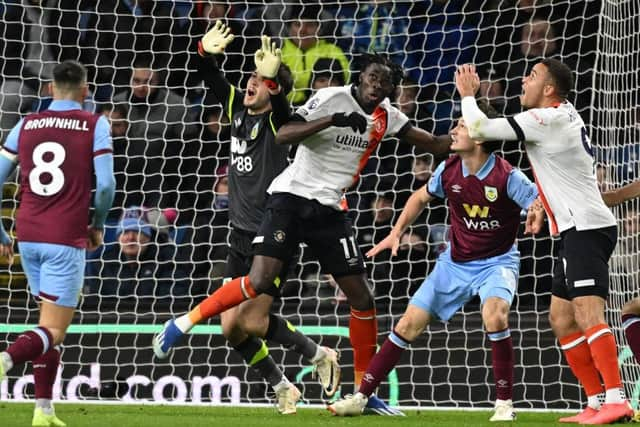VAR audio is released for Luton Town's controversial equaliser at Burnley
and live on Freeview channel 276
The VAR audio explaining why Luton Town forward Carlton Morris’s controversial late goal at Burnley last Friday night was allowed to stand has been released on the Match Officials: Mic'd Up show broadcast by Sky Sports this week.
The stoppage time equaliser sparked plenty of controversy, as Clarets keeper James Trafford, who had spent much of the game dropping to the floor for no apparent reason when collecting the ball, unwisely came out to claim Alfie Doughty’s hopeful cross. Clearly misjudging the flight of the delivery, he then collided with striker Elijah Adebayo allowing Morris to head into the empty net and make it 1-1. On-field referee Tony Harington awarded the goal, in agreement with his assistant, the decision then checked by VAR in Stockley Park for a foul on the England U21 international.
Advertisement
Hide AdAdvertisement
Hide AdVAR official Peter Bankes was happy to let it stand, although his assistant Constantine Hatzidakis questioned the call, feeling Adebayo used his body to impede Trafford, as the conversation went as follows. Harrington: Goal on-field I think Trafford runs into the forward just as much. Assistant: Yes I agree. I think Trafford goes into Adebayo. I think the forward stands his ground. VAR: The keeper comes out. We’ve got 11 move in. Side-on-side contact. AVAR: Does the attacker make a movement towards the goalkeeper?
VAR: The keeper can jump and use his arms, but because the keeper is coming out, I'm not seeing a clear and obvious error. Are you disagreeing? AVAR: It just feels like the attacker make a movement towards the goalkeeper. VAR: Yeah is it enough for a foul on the keeper who can jump and use his hands? As the keeper never jumps to try and play the ball. AVAR: I understand. VAR: Okay, I'm happy to confirm the on-field decision of goal.
Speaking on the programme, former Liverpool and England striker Michael Owen said: “It’s a really interesting one that one, split a lot of opinion, even the VAR assistant there, you could tell he wasn’t 100 per cent convinced. I happen to think it was a free kick myself.”
Meanwhile, former top flight referee and head of the Professional Game Match Officials Ltd (PGMOL) Howard Webb gave the reasons as to why VAR didn’t overrule Harrington on the evening, as he said: “The on-field decision is always important for us when we're thinking about how we utilise the addition of VAR. In this situation, the on-field officials felt there was no foul, they saw two players coming together. You hear the assistant referee in the moment confirming what the referee has seen as well, so the starting point is they don’t think its a foul.
Advertisement
Hide AdAdvertisement
Hide Ad"VAR looks at that in that context to see whether or not that decision in his opinion is a clear and obvious error. The AVAR actually felt it might be, you can hear him talking about the attacker’s movement. You see the goalkeeper Trafford coming out, you see Adebayo moving, he’s always moving in that direction, at the very end of the piece there’s a little movement towards the goalkeeper, some people see this as normal football contact.


"I can understand why Burnley would expect they should get a free kick in that situation but I’ve spoken to a whole host of people who don’t see it that way at all, who see it as that normal football contact that the officials on the field saw at that moment and the split between the VAR and AVAR is something that’s not very clear and VAR was brought in to rectify very clear situations. So I understand why you think a foul might be the better decision, but that’s a different question to whether or not the non award of a foul is clearly wrong.”
Discussing the goal afterwards, Town chief Rob Edwards conceded he was expecting it to be disallowed even though he felt the contact was ‘minimal’. Asked if he felt it demonstrated VAR wasn’t working as it should, he added: “That’s the problem with VAR there as that still comes down to someone’s opinion doesn’t it. it’s not like a factual black and white decision, is it really clear and obvious? Everyone in here will have different opinions on it, and people will see it from a different angle and go ‘there’s contact, or actually it doesn’t look too bad from another angle.’
"I just think we’re asking them to re-ref the game from miles away in a studio. So if the referee hasn’t given that decision on the field, then tonight, that decision away from here has gone from us. But it’s because it’s opinions and we’re all going to see it differently, that’s where it’s really hard with things like that. It can (work) for certain things if you do it on facts, factual decisions, offsides and things like that. I’ve said this before, when it comes down to someone’s opinion, no, you’re never going to get it spot on as everyone’s going to have different ideas on it.”